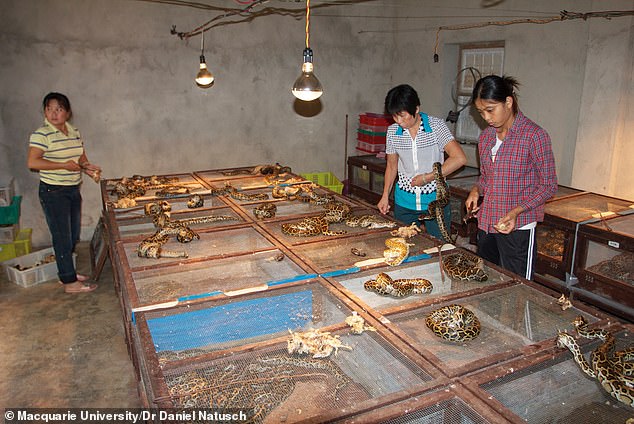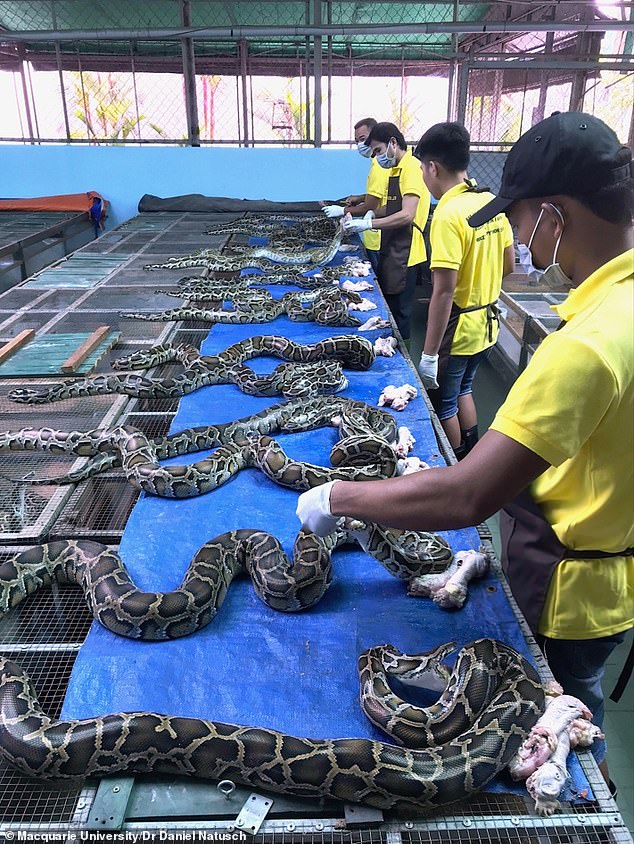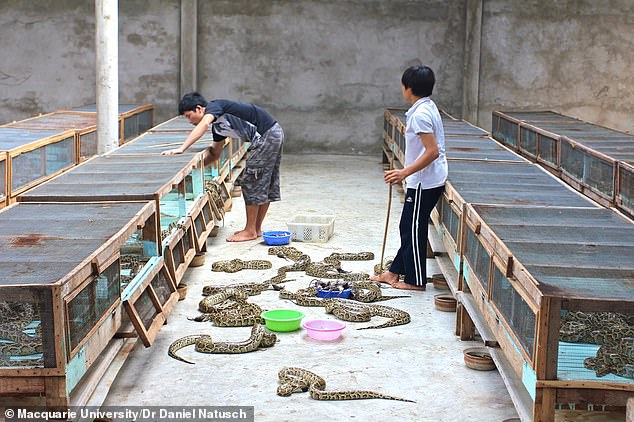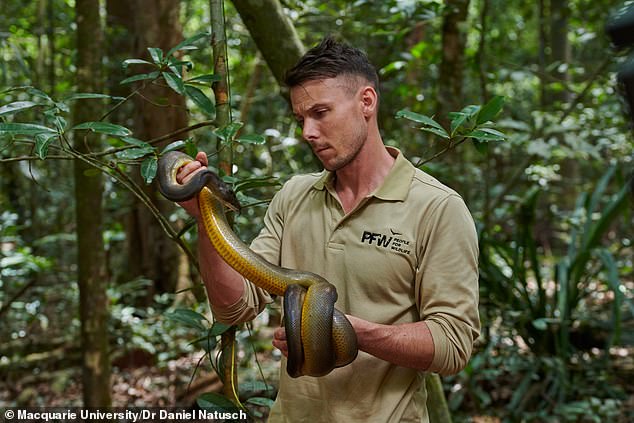Eating SNAKE is better for the environment than eating beef or chicken, research claims – so, would you try a python pie?
They are capable of a powerful bite that can cause nasty injuries.
And now scientists say pythons should be on the menu – at least for those of us who want to do our part to save the planet.
Experts from Macquarie University in Sydney claim that eating snakes is better for the environment than eating beef, chicken or even fish.
Pythons don’t need to eat much because they don’t use much energy and grow quickly when farming.
By comparison, chicken and beef are intensively farmed and require enormous amounts of land and feed, putting pressure on natural resources.
Scientists have measured the growth rates of two species of large pythons – the reticulated python (pictured) and the Burmese python – on farms in Thailand and Vietnam

Pythons are already widely consumed in Southeast Asian countries such as Vietnam and Thailand, but finding the meat in the Western world is more difficult. In the photo: Burmese python meat
The team of scientists, led by Dr. Daniel Natusch, outlined their argument in a new study published today.
For the study, Dr. Natusch and colleagues measured the growth rates of 4,601 large pythons of two species – the reticulated python and the Burmese python – on farms in Thailand and Vietnam.
Both species are non-venomous and are farmed in Asia for their skin and meat.
The pythons were fed a variety of locally sourced proteins, including wild-caught rodents, pork sausages, chicken and fishmeal.
Researchers found that both python species grew rapidly over a twelve-month period, despite not needing to be fed as frequently as other livestock animals such as chickens and cows.
Regular measurements of the pythons showed that they continued to grow even when fed only once a week.
“They still grew, and faster than chickens, pigs, cows, crickets and salmon that were fed more often,” Dr. Natusch said.

Farmed python meat could provide a more sustainable alternative to other farmed meats, analysis of python growth rates suggests. Pictured: Workers in China with Burmese pythons (Python bivittatus)

Workers in Vietnam take meat from dead Burmese pythons, which is described as tough and looks a bit like chicken
Even without eating for 4.2 months, the pythons survived and lost some weight, but at a “ridiculously” slow rate, resuming rapid growth once eating resumed.
Amazingly, large pythons can live without food for almost a year and still survive.
“If you don’t feed a chicken for three to five days, it will die,” Dr. Natusch added.
‘This is why they are such a great animal for a future where climate volatility, economic volatility and resource volatility will increase.
‘They are the most efficient and resilient protein source we know to date.’
The team also found that female pythons grew faster than males – a sex-based difference that is common among snakes in general.
Dr. Natusch said he has eaten python meat “several times” and describes it as “tasty and versatile.”
“I have had it barbecued, as satay skewers and in curries,” he tells MailOnline.
‘I have also eaten it as Biltong (uncooked but dried meat with herbs).
‘It may sound cliché, but it looks a bit like chicken.’
Pythons are already widely consumed in Southeast Asian countries such as Vietnam and Thailand, but finding the meat in the Western world is more difficult.
However, in Florida, the Burmese python is served on pizzas, where the non-native species is considered an invasive pest because it competes with native wildlife for food.
The Everglades Pizza, named after Florida’s vast national park, was served at Evan’s Neighborhood Pizza in Fort Myers, along with alligator sausage and frog legs.
One couple who tried it described python meat as “like chicken” and “good but a little tough.”
Another internet user described python meat as “a bit sweet with a slightly gamey taste,” but added that it is “very tough and chewy.”
In addition, python meat is low in fat and calories, and is rich in protein, nutrients and essential amino acids.

Even without eating for 4.2 months, the pythons survived and lost some weight, but at a very slow rate. In the photo the Burmese python

Reticulated and Burmese pythons grew rapidly over a twelve-month period, despite not needing to feed as frequently as other livestock animals. In the photo: workers in Vietnam with Burmese pythons

Dr. Daniel Natusch, a biologist at Macquarie University, holds an Australian water python (Liasis fuscus) – a species that is not farmed (it is a wild python)
Based on the findings, the experts say commercial python farming could be a viable and sustainable option for food production around the world.
They emphasize the need for further research into the most effective and humane ways to produce them worldwide.
“Python farming is well established in Asia, but has received little attention from mainstream agricultural scientists,” say Dr. Natusch and colleagues in their article, published in Scientific reports.
‘The ability of fasting pythons to regulate metabolic processes and maintain body condition improves food security in volatile environments.
‘Python farming can provide a flexible and efficient response to global food insecurity.’
